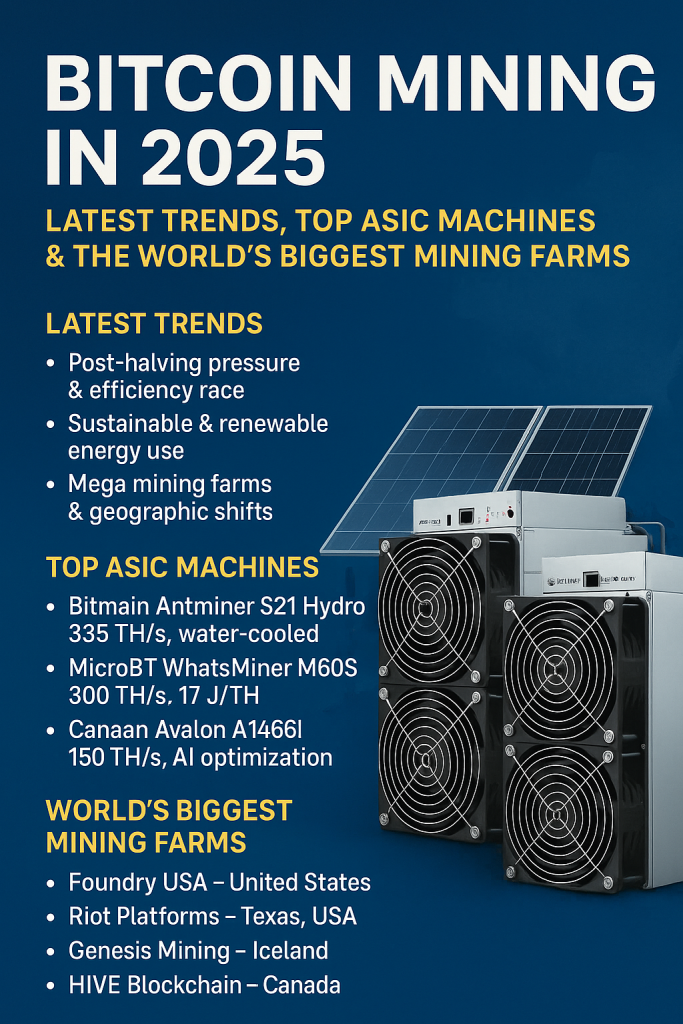Bitcoin mining remains one of the most critical components of the cryptocurrency ecosystem. As we move deeper into 2025, mining continues to evolve rapidly with powerful new ASIC machines, an increased focus on sustainability, and the expansion of mega-sized mining farms across the globe.
This guide will walk you through what Bitcoin mining is, the latest trends shaping the industry, the best mining hardware available today, and a look inside some of the world’s largest mining operations. We’ll also briefly explore other cryptocurrencies still using Proof-of-Work (PoW).
🔹 What Is Bitcoin Mining?
Bitcoin mining is the process of validating transactions and securing the Bitcoin network by solving complex cryptographic puzzles. Miners compete to be the first to solve each puzzle, and the winner gets to add a new block to the blockchain, receiving a reward in newly minted bitcoins and transaction fees.
This process relies on the Proof-of-Work (PoW) consensus mechanism and requires significant computing power and energy. With each Bitcoin halving (the most recent occurred in April 2024), block rewards are reduced—making efficiency more crucial than ever.
🔹 Latest Bitcoin Mining Trends in 2025
1. Post-Halving Pressure & Efficiency Race
After the 2024 halving reduced block rewards from 6.25 BTC to 3.125 BTC, miners are under pressure to reduce operating costs and maximize performance. Only the most energy-efficient and high-hashrate setups remain profitable.
2. Sustainable & Renewable Energy Use
The environmental impact of mining has drawn global attention. In response, many miners now operate in regions with cheap, clean energy:
- Iceland & Norway – Geothermal and hydro power
- Texas, USA – Wind and solar integration with grid balancing
- Canada – Abundant hydroelectric energy
This shift is not just environmental—it’s also economical, as electricity is the biggest cost factor in mining.
3. Mega Mining Farms & Geographic Shifts
Regulations have pushed mining out of countries like China, redirecting investment to North America, Central Asia, and parts of South America. Massive, industrial-scale mining farms now dominate Bitcoin’s hash power.
4. Mining-as-a-Service (MaaS) & Cloud Solutions
Companies offer hosted mining services, allowing individuals and investors to mine without setting up hardware. This trend makes mining more accessible but also comes with trust and ROI concerns.
5. Decentralized Mining Pools
To reduce centralization risks, miners are joining non-custodial, transparent pools like Ocean or ViaBTC, where they retain control of their mining rewards and payout transparency is emphasized.
🔹 Top ASIC Mining Machines of 2025
Mining hardware is the foundation of any operation. The newest generation of ASIC (Application-Specific Integrated Circuit) miners is optimized for performance and energy savings.
🔸 1. Bitmain Antminer S21 Hydro
- Hashrate: 335 TH/s
- Efficiency: ~16 J/TH
- Cooling: Advanced water-cooled system
- Highlights: Ideal for large-scale, high-density mining farms.
🔸 2. MicroBT WhatsMiner M60S
- Hashrate: 300 TH/s
- Efficiency: ~17 J/TH
- Known for: Reliability, simple firmware, and lower failure rate.
🔸 3. Canaan Avalon A1466I
- Hashrate: 150 TH/s
- Features: Built-in AI optimization, better thermal controls.
- Use case: Mid-sized farms and power-sensitive operations.
These machines are in high demand and form the backbone of 2025’s top mining farms.
🔹 Leading Bitcoin Mining Farms in the World
Bitcoin mining is no longer a garage operation. Massive farms—some the size of data centers—are now driving most of the network’s hash power.
🔸 1. Foundry USA – United States
- The largest mining pool in North America.
- Backed by Digital Currency Group.
- Operates large-scale mining with sustainable energy integration.
🔸 2. Riot Platforms – Texas, USA
- One of the biggest Bitcoin miners globally.
- Strategically located to access Texas’ renewable energy grid.
- Focuses on eco-friendly, large-scale operations.
🔸 3. Genesis Mining – Iceland
- Early adopter of green energy for mining.
- Operates in Iceland using geothermal power.
- Also offers cloud mining services.
🔸 4. HIVE Blockchain – Canada & Europe
- Publicly traded and ESG-focused.
- Leverages hydropower in Canada and Sweden.
- Diversifies with mining of other PoW coins.
🔸 5. Bitmain Farms – Kazakhstan, USA
- Despite China’s crackdown, Bitmain continues offshore mining.
- Runs some of the most efficient, high-density farms.
These entities control significant portions of the global hash rate, influencing block generation and mining profitability.

🔹 Other Mineable Cryptocurrencies (2025)
While Bitcoin dominates mining, several altcoins still use PoW and can be mined with GPUs or CPUs:
- Litecoin (LTC): Uses Scrypt; often mined alongside Dogecoin.
- Monero (XMR): Uses RandomX; privacy coin that supports CPU mining.
- Ethereum Classic (ETC): Continues to use Etchash after Ethereum’s PoS shift.
- Kaspa (KAS): A fast-emerging PoW project using DAG and kHeavyHash.
These coins are especially attractive for hobbyists or miners priced out of Bitcoin mining.
🔹 Final Thoughts
In 2025, Bitcoin mining is more competitive and industrialized than ever. The combination of cutting-edge ASIC hardware, geographic migration, and a global push for green energy is reshaping the entire landscape.
Whether you’re an investor, miner, or enthusiast, understanding these trends—and staying updated on the latest machines and farms—is essential. Bitcoin’s next halving cycle is already in sight, and the mining race is only getting hotter.